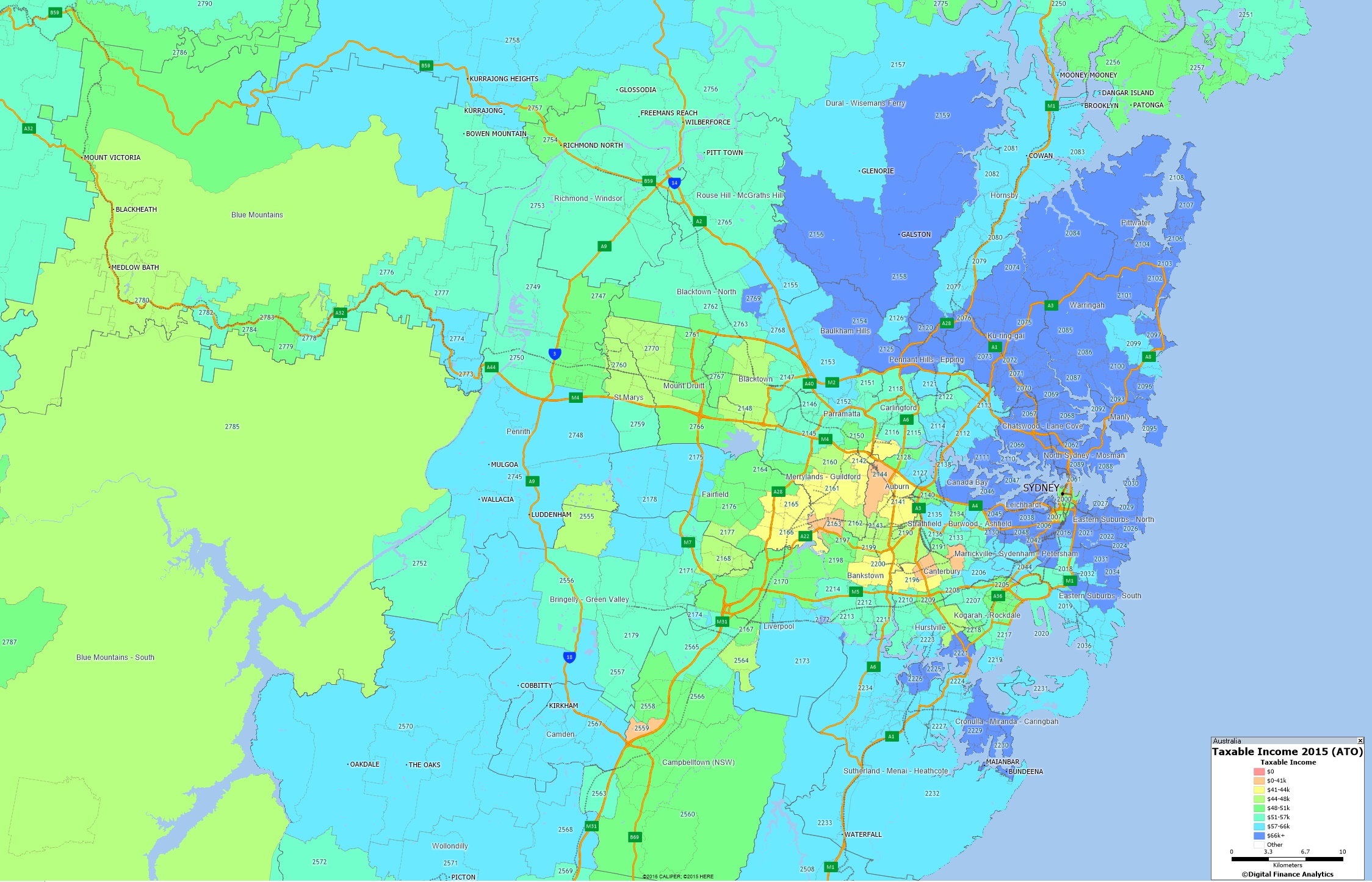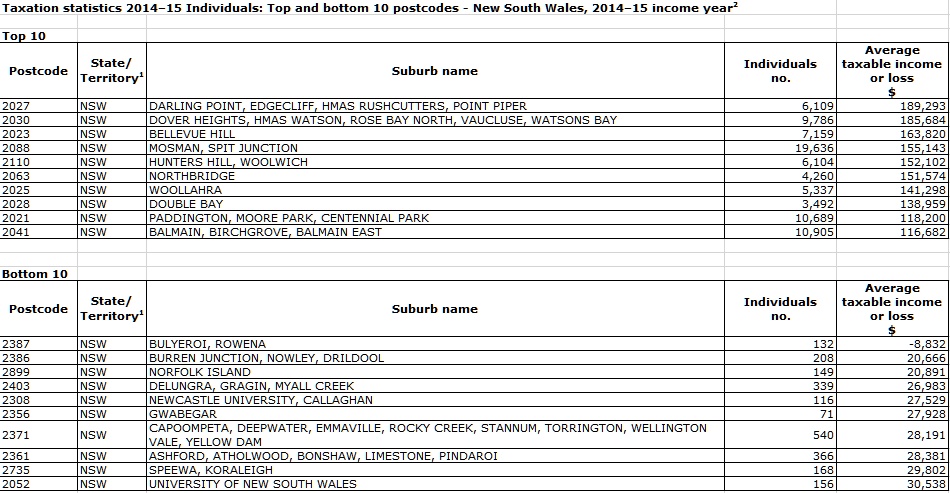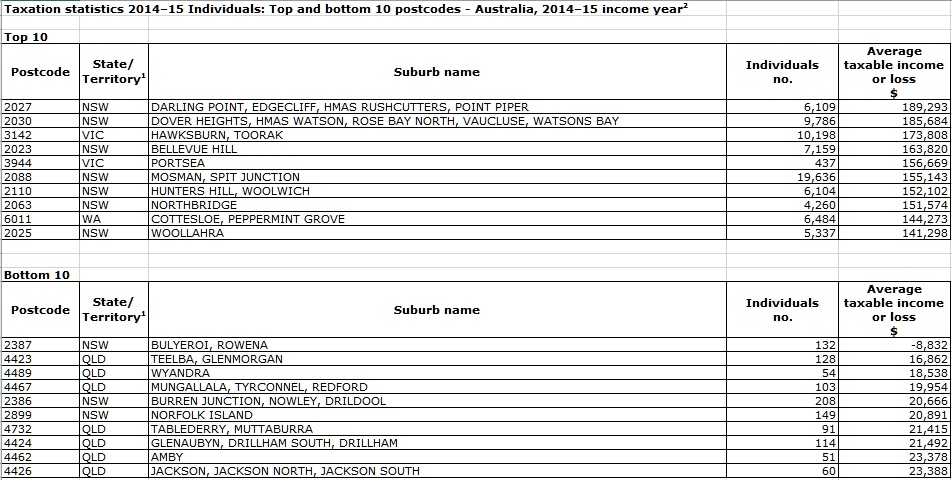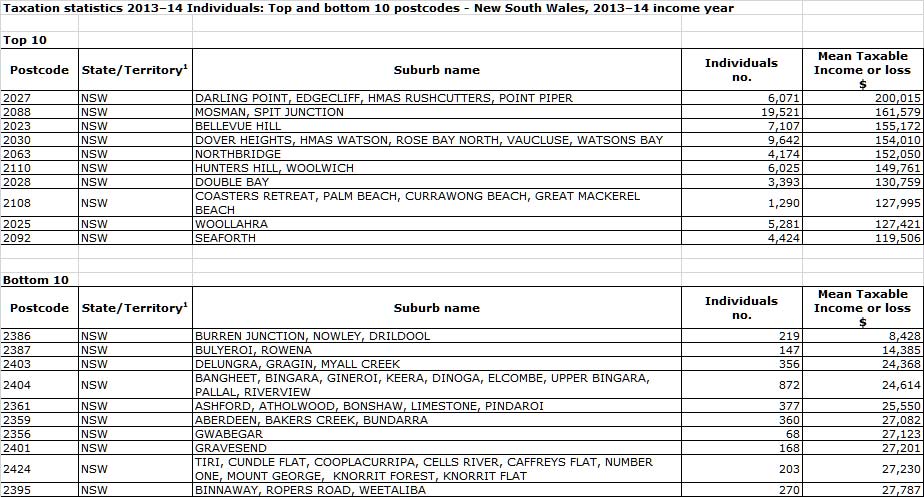Here is the geomap for Greater Sydney, using the recently released 2015 taxable income data from the ATO, as a drill down on the all Australia data we previously posted. Blue shows the higher taxable income areas.
Tag: ATO
Taxable Income Mapping Australia 2015
Using data from the latest ATO release from 2015, we can map average taxable incomes to post codes. Of course taxable incomes are the residual amounts the tax authorities get their hands on after tax management strategies (such as allowances, expenses, trusts, negative gearing, income sharing and the like) so they do not tell the full story. Nevertheless the results are interesting.
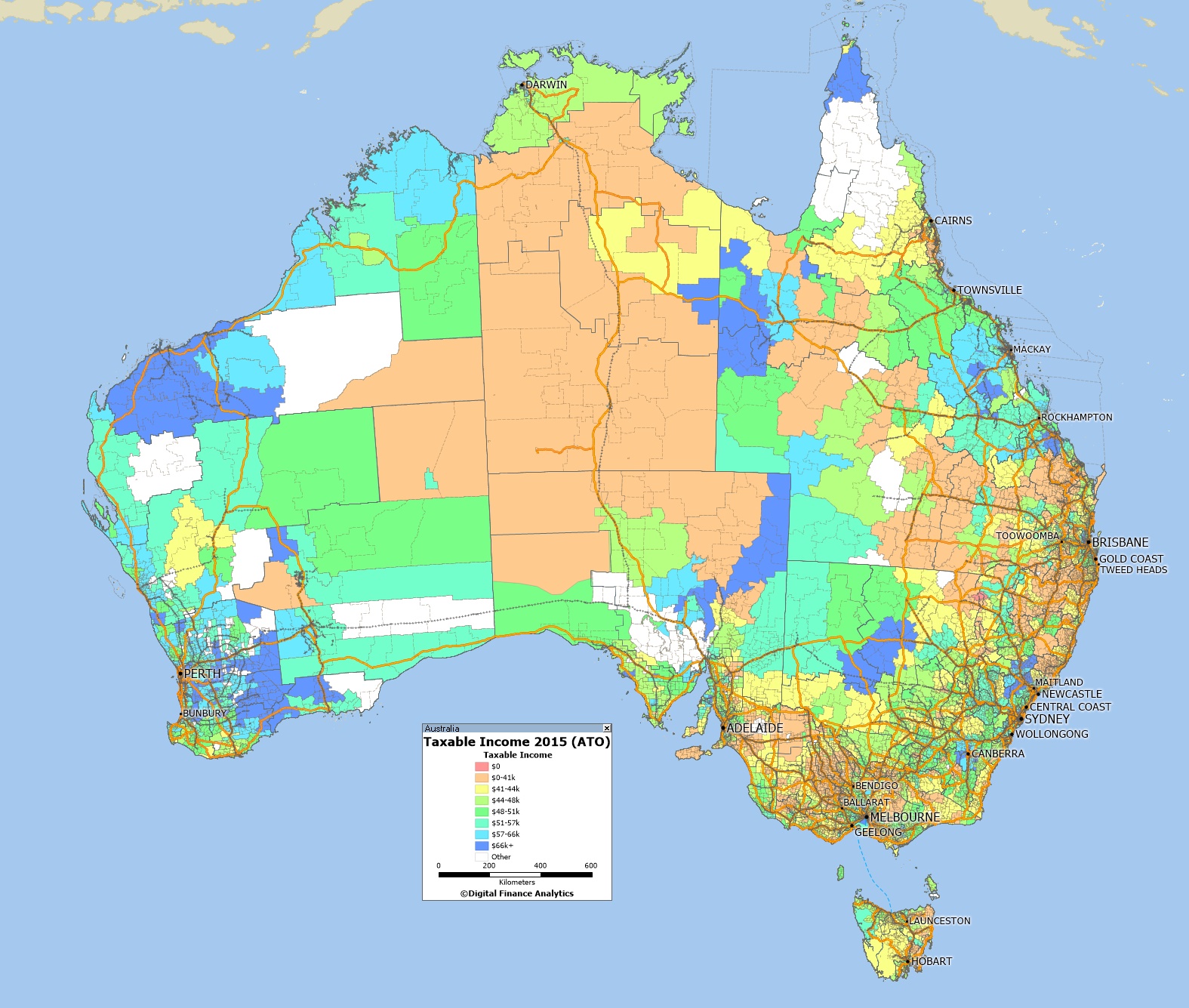 The blue areas show the zones of highest taxable income. Here are the top and bottom postcodes from the list, Australian wide.
The blue areas show the zones of highest taxable income. Here are the top and bottom postcodes from the list, Australian wide.
In coming days we will drill into the various states, again with interesting results.
Negative Gearing In Action
The ATO released their summary FY15 data this week, and included quite comprehensive summaries of the range of costs those with rental properties have offset income. They also divide rentals into those functioning at a loss, and those who make a profit.
Of the 2.9 million rentals, 1.1 million made a profit, the rest a loss (which can be offset against other categories of income). That means 60% of rentals are under water.
We can also see the categories of costs claimed and the average amounts. Not all households claim all categories.
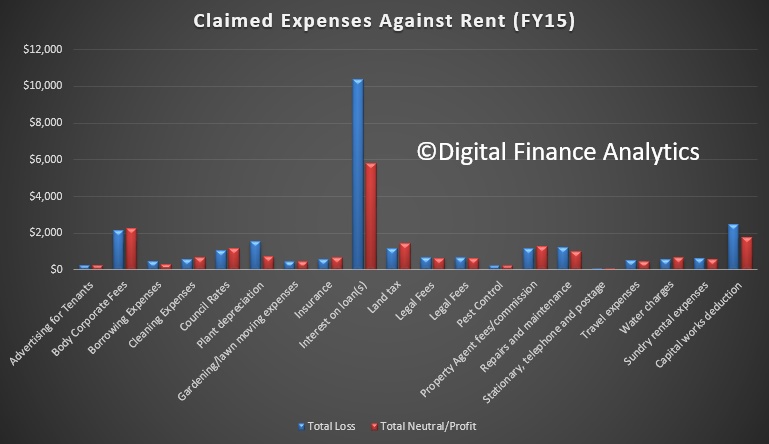 Significantly, the major factor between loss and profit is the interest amount. Those reporting a loss had bigger interest payments (presumably larger loans?). But it is also worth looking at the 20 categories (yes 20!!) which can be claimed. Behold the wonders of our generous tax system, and the reason why so many do not want it to stop.
Significantly, the major factor between loss and profit is the interest amount. Those reporting a loss had bigger interest payments (presumably larger loans?). But it is also worth looking at the 20 categories (yes 20!!) which can be claimed. Behold the wonders of our generous tax system, and the reason why so many do not want it to stop.
ATO reveals Australia’s richest and poorest postcodes
Sydney’s eastern suburbs have retained their title as the home of Australia’s richest residents.
That’s the word from the Australian Taxation Office, which names postcode 2027 as the single largest concentration of blue-chip earners in the nation, with an average individual income of $189,293, based on newly released tax return statistics from 2014-15.
That shouldn’t come as a surprise. The plush pocket of harbourside high-earners includes Point Piper, where Prime Minister Malcolm Turnbull makes his home in a waterfront mansion estimated by Domain.com.au to be worth as much as $50 million.
That makes him wealthy even by the solid-gold standards of neighbouring Darling Point, Edgecliff and Rushcutters Bay, all in the same 2027 postcode.
NSW accounted for seven of the top 10 rated postcodes, while Victoria occupies two rungs at the top of the wealth ladder, according to the data released on Wednesday for the 2014-15 year.
That’s the upside. The other side of the coin is that the state also has the poorest postcodes, with the 132 residents of Bulyeroi, in the north-central part of the state, scraping by on an average taxable loss – yes, loss – of $8832.
That makes Bulyeroi the most down-at-heel town in the entire country.
Overall pauper honours, however, go to Queensland, where seven of the poorest postcodes are to be found. The other three entries at the bottom of the income ladder are all in NSW.
The Melbourne suburb of Toorak is the third-richest, with the Victorian seaside town of Portsea, grandly positioned at the entrance to Port Phillip Bay, ranking fifth in the wealth stakes.
The only other state to figure in the top 10 was Western Australia, where Cottesloe/Peppermint Grove secured the ninth spot, just ahead of Sydney’s Woollahra on $144,273.
The most common professions reported among the top 10 postcodes included medical specialists and practitioners, financial dealers, psychiatrists, judicial and other legal professionals, mining engineers, chief managing directors, and engineering managers.
Surgeons were the highest earners, with an average taxable income of $377,044, followed by anaesthetists at $341,041.
Australia’s wealthiest postcodes, by suburb
- 2027 (NSW): Darling Point, Edgecliff, Hmas Rushcutters, Point Piper
- 2030 (NSW): Dover Heights, Hmas Watson, Rose Bay North, Vaucluse, Watsons Bay
- 3142 (VIC): Hawksburn, Toorak
- 2023 (NSW): Bellevue Hill
- 3944 (VIC): Portsea
- 2088 (NSW): Mosman, Spit Junction
- 2110 (NSW): Hunters Hill, Woolwich
- 2063 (NSW): Northbridge
- 6011 (WA): Cottesloe, Peppermint Grove
- 2025 (NSW): Woollahra
Australia’s poorest postcodes, by suburb
- 2387 (NSW): Bulyeroi, Rowena
- 4423 (QLD): Teelba, Glenmorgan
- 4489 (QLD): Wyandra
- 4467 (QLD): Mungallala, Tyrconnel, Redford
- 2386 (NSW): Burren Junction, Nowley, Drildool
- 2899 (NSW): Norfolk Island
- 4732 (QLD): Tablederry, Muttaburra
- 4424 (QLD): Glenaubyn, Drillham South, Drillham
- 4462 (QLD): Amby
- 4426 (QLD): Jackson, Jackson North, Jackson South
DFA notes this a TAXABLE INCOME, so after offsets and other tax saving measures. It tells you little about the status of gross household income.
ATO services drop out ahead of Christmas break
From Smart Company. ATO services drop out ahead of Christmas break, as SMEs continue to grapple with two-week long outage.
The Australian Taxation Office online services have gone offline again on the last day before the organisation’s Christmas shutdown.
At 8:45am this morning the tax agent portal, business portal and central ATO website were unavailable to individuals and businesses, with an error message stating that the portals are either currently under maintenance or “unavailable”.
At 11:30am the websites were back online, however an spokesperson for the tax office told SmartCompany: “We do expect intermittent disruptions over the Christmas and New Year break as we continue to restore our systems”.
On Thursday evening the office notified clients that it would be closing for Christmas shutdown today and reopening on January 3. The message advised visiting the service updates webpage to track progress of the system restoration, however, this morning that link went to an error page.
The tax office experienced a major outage of its services on Sunday, December 11, and has spent the following two weeks working with technicians and its storage provider Hewlett Packard to restore systems from backups.
While limited services were restored earlier this week, tax agents and accountants have told SmartCompany this is the worst outage they have seen and the continued service interruption has come at a cost of thousands.
This morning businesses and individuals expressed frustration about another drop out in the final trading hours before Christmas.
“I would love to check your system update media release, but your website is down again,” said one client on Facebook.
Clients have complained on Twitter this morning that they have been unable to complete transactions, including departing Australian superannuation payments and voluntary HELP repayments.
“Some of our services are unavailable; we’re trying to restore them as soon as we can. We apologise for the inconvenience,” the ATO replied to one individual on Twitter.
The ATO’s chief information officer has consistently assured the public that no individual or business will be disadvantaged by the situation, but members of the public remain stressed about the payment of tax refunds and the strain this has put on accountants in the lead up to the year’s end.
Proposed Financial Institutions Supervisory Levies For 2016-7
The financial industry levies are set to recover the operational costs of APRA and other specific costs incurred by certain Commonwealth agencies and departments, including the Australian Securities and Investments Commission, the Australian Taxation Office, and the Department of Human Services. ASIC gets a 150% uplift, reflecting the requirement for greater supervision of across financial services.
The Treasury has released a paper, prepared in conjunction with the Australian Prudential Regulation Authority (APRA), seeking submissions on the proposed financial institutions supervisory levies that will apply for the 2016-17 financial year by Friday, 3 June 2016.
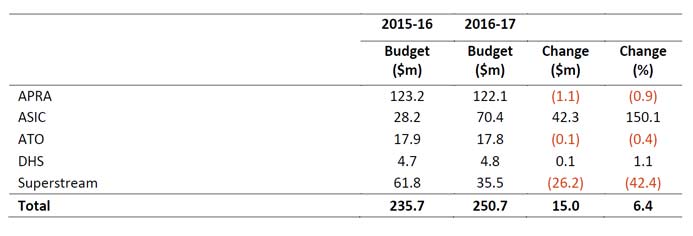 Here they are itemised by industry segment.
Here they are itemised by industry segment.
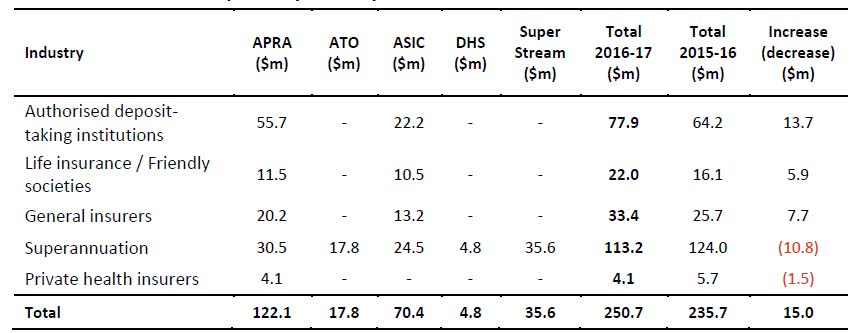 Australian Securities and Investments Commission component
Australian Securities and Investments Commission component
A component of the levies is collected to partially offset ASIC’s regulatory costs in relation to consumer protection, financial literacy, regulatory and enforcement activities relating to the products and services of APRA regulated institutions as well as the operation of the Superannuation Complaints Tribunal (SCT). In addition, the levies are used to offset the cost of a number of Government initiatives including the over the counter (OTC) derivatives market supervision reforms and ASIC’s MoneySmart programmes.
$70.4 million will be recovered to offset ASIC regulatory costs through the levies in 2016-17. This amount is 150.1 per cent more than in 2015-16 as a consequence of the Government’s decisions to provide funding to the SCT to deal with legacy complaints and improve processes and infrastructure ($5.2 million) and to bolster ASIC to protect Australian consumers ($37.0 million).
As part of the improving outcomes in financial services package, the Government will:
- invest $61.1 million over four years to enhance ASIC’s data analytics and surveillance capabilities as well as modernise ASIC’s data management systems;
- provide ASIC with $57.0 million over four years to enable increased surveillance and enforcement in the areas of financial advice, responsible lending, life insurance and breach reporting; and
- accelerate the implementation of a number of key measures recommended by the Financial System Inquiry.
From 2017-18 onwards, ASIC’s regulatory costs will be recovered from all industry sectors regulated by ASIC. The Government will consult extensively with industry to refine and settle an industry funding model for ASIC.
Australian Taxation Office component
Funding from the levies collected from the superannuation industry includes a component to cover the ATO’s regulatory costs in administering the Superannuation Lost Member Register (LMR) and Unclaimed Superannuation Money (USM) frameworks. In 2016-17, it is estimated that the total cost to the ATO in undertaking these functions will be $17.8 million, with the full amount to be recovered through the levies in line with the requirements of the Government’s Charging Framework.
The majority of this funding supports the ATO’s activities, which include:
- the implementation of strategies to reunite individuals with lost and unclaimed superannuation money including promotion of the ATO On Line Individuals Portal and targeted SMS/e mail campaigns;
- working collaboratively with funds to engage members being reunited with their super, including Super Match and providing funds with updated contact information about their lost members;
- processing of lodgements, statements and other associated account activities;
- processing of claims and payments, including the recovery of overpayments;reviewing and improving the integrity of data on the LMR and in the USM system; and
- reviewing and improving data matching techniques, which facilitates the display of lost and unclaimed accounts on the ATO On Line Individuals Portal.
The funding also supports the ongoing upkeep and enhancement of the ATO’s administrative system for USM frameworks and the LMR, and for continued work to improve efficiency and automate processing where applicable.
Department of Human Services component
The Department of Human Services administers the Early Release of Superannuation Benefits on Compassionate Grounds programme (ERSB). The compassionate grounds enable the Regulator (the Chief Executive of Medicare) to consider the early release of a person’s preserved superannuation in specified circumstances.
The volume of ERSB applications has significantly increased since it was made possible to apply online. In 2015-16, the ERSB received 27,688 applications. This was a 44 per cent increase compared with the previous year. In 2016-17, the ERSB is forecast to receive approximately 38,763 applications. This will represent an approximate increase in volume of 40 per cent compared with the previous year.
The programme is expected to cost the Government $4.8 million in 2016-17. In line with the Government’s Charging Framework, this amount will be recovered in full through the levies.
SuperStream component
Announced as part of the former Government’s Stronger Super reforms, SuperStream is a collection of measures that are designed to deliver greater efficiency in back-office processing across the superannuation industry. Superannuation funds will benefit from standardised and simplified data and payment administration processes when dealing with employers and other funds and from easier matching and consolidation of superannuation accounts. The costs associated with the implementation of the SuperStream measures are to be collected as part of the levies on superannuation funds. The levies will recover the full cost of the implementation of the SuperStream reforms and are to be imposed as a temporary levy on APRA-regulated superannuation entities from 2012-13 to 2017-18 inclusive.
The costs associated with the implementation of the SuperStream reforms are estimated to be $35.5 million in 2016-17 and $32.0 million in 2017-18.
Sydney Region Taxable Income Heat Map 2014
The ATO has just released its data for the 2013-2014 tax year. We have taken the average taxable income by post code and geo-mapped the data for NSW, centred on Sydney. The maps are based on clustered averages, distributed by the number of tax payers.
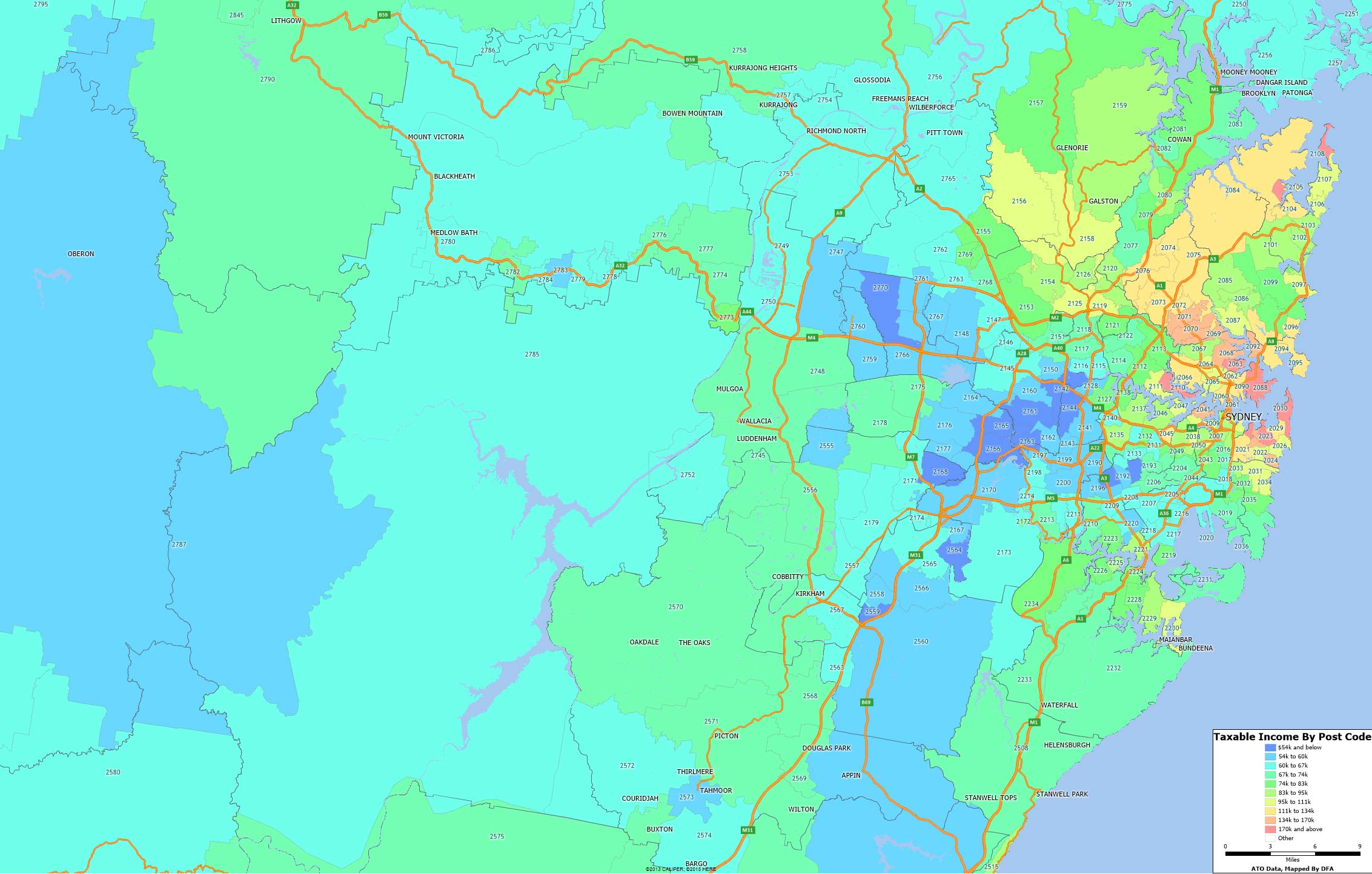 There are significant variations, of course (and this does not take account of those who have used various tax treatments to reduce their true income). The pink/red areas are the highest zones, the blue the lowest.
There are significant variations, of course (and this does not take account of those who have used various tax treatments to reduce their true income). The pink/red areas are the highest zones, the blue the lowest.
Another table gives the top and bottom post codes in NSW.

